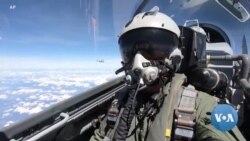ສະຫະລັດ ຍີ່ປຸ່ນ ແລະ ເກົາຫຼີໃຕ້ ໄດ້ຕົກລົງເຫັນດີເພື່ອຂະຫຍາຍການຮ່ວມມືທາງທະຫານຢ່າງເລິກເຊິ່ງ ແລະ ກ່າວປະນາມ “ພຶດຕິກຳທີ່ດຸຮ້າຍ ແລະ ອັນຕະລາຍ” ຂອງຈີນ ຢູ່ໃນທະເລຈີນໃຕ້ ຫຼັງຈາກກອງປະຊຸມສຸດຍອດ ສາມຝ່າຍ ເມື່ອກາງເດືອນສິງຫາ. ຈີນ ໄດ້ເພີ້ມທະວີກິດຈະກຳທາງການທະ ຫານຢ່າງຫຼວງຫຼາຍຢູ່ອ້ອມແອ້ມເກາະໄຕ້ຫວັນ ຊຶ່ງປັກກິ່ງ ເຫັນວ່າ ເປັນສ່ວນ ນຶ່ງຂອງເຂດນ້ຳແດນດິນຕົນ ຈຶ່ງກໍ່ໃຫ້ມີຄວາມຢ້ານກົວວ່າ ຈີນ ອາດເລີ້ມຕົ້ນ ການບຸກລຸກ. ດັ່ງທີ່ ເຮນຣີ ຣິຈແວລ ໄດ້ລາຍງານຈາກນະຄອນຫຼວງ ໂຕກຽວ ວ່າ ຍີ່ປຸ່ນ ແລະ ສະຫະລັດ ກໍກຳລັງເສີມຂະຫຍາຍການປະສານງານແລະ ຄວາມອາດສາມາດດ້ານທະຫານຮ່ວມກັນ ໃນຂະນະທີ່ຄວາມເຄັ່ງຕຶງຢູ່ໃນຂົງ ເຂດແຫ່ງນີ້ ສູງຂຶ້ນນັບມື້, ໄຊຈະເລີນສຸກ ຈະນຳລາຍລະອຽດມາສະເໜີທ່ານ ໃນອັນດັບຕໍ່ໄປ.
ພວກເຮືອບິນ ແລະກຳປັ່ນລົບຂອງຈີນຫຼາຍລຳ ໄດ້ປິດລ້ອມເກາະໄຕ້ຫວັນ ອີກຄັ້ງນຶ່ງ ໃນໄລຍະບໍ່ເທົ່າວັນມານີ້.
ປັກກິ່ງມີຄວາມພ້ອມຫຼາຍປານໃດ ທີ່ຈະເຂົ້າສູ່ສົງຄາມເພາະໄຕ້ຫວັນ?
ທ່ານແກຣ້ນ ນິວແຊມ ຢູ່ທີ່ສູນກາງເພື່ອນະໂຍບາຍດ້ານຄວາມໝັ້ນຄົງ ກ່າວວ່າ “ພວກເຂົາເຈົ້າໄດ້ນຳເອົາອຸປະກອນຕ່າງໆມາຕຽມພ້ອມໄວ້. ພວກເຮົາເຫັນພວກ ເຂົາທົດລອງມັນຕະຫຼອດໄລຍະປີເຄິ່ງທີ່ຜ່ານມາ ຫຼື ປະມານນັ້ນ. ພວກເຂົາມີ ທັງລູກສອນໄຟ, ຄອມພິວເຕີ ແລະ ອີເລັກໂທຣນິກ. ພວກເຂົາຍັງມີກຳປັ່ນລົບ ແລະເຮືອບິນຫຼາຍລຳອອກໄປປະຕິບັດການເປັນປົກກະຕິ ແລະ ສິ່ງສຸດທ້າຍ ທີ່ຂ້າພະເຈົ້າຄິດວ່າ ພວກເຮົາຈະເຫັນໃນລະດູໃບໄມ້ຫຼົ່ນນີ້ ແມ່ນການຊ້ອມຍົກ ພົນຂຶ້ນບົກ.”
ສ່ວນຄົນອື່ນໆ ກ່າວວ່າ ປັກກິ່ງ ຮູ້ເຖິງຄວາມສ່ຽງຕ່າງໆທີ່ລວມຢູ່ນຳ.
ທ່ານ ຄຣິສໂຕເຟີ ຈອນສ໌ໂຕນ ເປັນນັກວິເຄາະ ຢູ່ສູນກາງດ້ານຍຸທະສາດ ແລະການສຶກສາສາກົນ ຢູ່ໃນວໍຊິງຕັນ ໄດ້ກ່າວຜ່ານທາງຊູມ (Zoom) ວ່າ “ການປະຕິບັດການທີ່ກະຕືລືລົ້ນຂ້າມມະຫາສະໝຸດ 100 ໄມ ຫຼື 161 ກິໂລແມັດ ຕໍ່ເກາະແຫ່ງນຶ່ງ ທີ່ມີການເສີມກຳລັງປ້ອງກັນຂ້ອນຂ້າງດີ ແລະມີພື້ນທີ່ທີ່ກັນດານຫຼາຍ ນຳດ້ວຍ ທີ່ຍັງຄົງເປັນຄວາມພະຍາຍາມທີ່ມີຄວາມສ່ຽງສູງ.”
ວໍຊິງຕັນ ໄດ້ຍຶດຖືນະໂຍບາຍຂອງ “ຍຸດທະສາດທີ່ຄຸມເຄືອ” ມາຍາວນານ ກ່ຽວກັບວ່າ ຕົນຈະເຂົ້າແຊກແຊງດ້ານການທະຫານໃນເກາະ ໄຕ້ຫວັນ ຫຼືບໍ່. ແຕ່ສະຫະລັດ ແລະບັນດາພັນທະມິດຂອງຕົນຢູ່ໃນພາກພື້ນ ແມ່ນກຳລັງເສີມຂະຫຍາຍການຮ່ວມມືດ້ານການທະຫານນຳກັນ.
ສະຫະລັດ ມີທະຫານຫ້າສິບພັນຄົນປະຈຳການຢູູ່ໃນຍີ່ປຸ່ນ. ທ່ານ ນິວແຊມ ໄດ້ໂຕ້ແຍ້ງວ່າ ກຸ່ມພັນທະມິດຕ້ອງປະສານງານຮ່ວມກັນໃຫ້ດີຂຶ້ນກວ່າເກົ່າ.
ທ່ານອະທິບາຍວ່າ “ມັນບໍ່ມີສຳນັກງານໃຫຍ່ຮ່ວມກັນເລີຍ ລະຫວ່າງສະຫະລັດ ແລະຍີ່ປຸ່ນ ແລະນັ້ນແມ່ນຫຼັງຈາກ 60 ກວ່າປີແລ້ວ ໃນການເປັນພັນທະມິດດ້ານການປ້ອງກັນປະເທດ. ດັ່ງນັ້ນມັນເຮັດໃຫ້ງົງແທ້ໆ. ມັນຕ້ອງໄດ້ຖືກແກ້ໄຂຢ່າງວ່ອງໄວ.”
ລັດຖະສະພາສະຫະລັດ ກຳລັງອະພິປາຍໃນເລື່ອງການປະຕິຮູບ ກ່ຽວກັບ ໂຄງຮ່າງຂອງກອງບັນຊາການທະຫານໃນຍີ່ປຸ່ນ ເພື່ອອຳນວຍຄວາມສະດວກ ໃນການປະສານງານກັບກອງກຳລັງຂອງຍີ່ປຸ່ນ ໃຫ້ດີຂຶ້ນກວ່າເກົ່າ ລວມທັງສູນບັນຊາການຮ່ວມ ນຳດ້ວຍ.
ໃນຂະນະດຽວກັນ ຍີ່ປຸ່ນ ເມື່ອປີກາຍນີ້ ໄດ້ປະກາດທີ່ຈະເພີ້ມການໃຊ້ຈ່າຍດ້ານ ການປ້ອງກັນປະເທດ ຂຶ້ນເປັນສອງເທົ່າພາຍໃນປີ 2027.
ທ່ານ ຈອນສ໌ໂຕນ ກ່າວວ່າ “ຍີ່ປຸ່ນ ເປັນບ່ອນທີ່ສະຫະລັດ ຈະສະແດງກຳລັງ ອຳນາດອອກມາໄດ້ ແລະນັ້ນ ເປັນຈຸດເລີ້ມຕົ້ນຢູ່ທີ່ນີ້. ແຕ່ຍີ່ປຸ່ນ ເປັນມະຫາ ອຳນາດທາງທະຫານທີ່ສຳຄັນດ້ວຍຕົນເອງຕາມລຳພັງ ເພີ້ມຂຶ້ນນັບມື້ ຮ່ວມທັງໃນຄວາມອາດສາມາດຕ່າງໆ ປະເພດທີ່ຕົນມີ ເຊັ່ນວ່າ ຕົນມີເຮືອບິນລົບ F-35 ຍົກຕົວຢ່າງ ກອງທັບເຮືອທີ່ມີຄວາມອາດສາມາດ ແລະທັນສະໄໝທີ່ໂດດເດັ່ນ ເປັນພິເສດ, ທັງຄວາມອາດສາມາດໃນການປ້ອງກັນລູກສອນໄຟທີ່ແຂງແກ່ນ ແລະດຽວນີ້ ໃນຂະນະທີ່ພວກເຂົາເລີ້ມຕົ້ນຍຸດທະສາດທາງດ້ານການປ້ອງກັນ ຊາດໃໝ່ນັ້ນ ເຂົາເຈົ້າໄດ້ລົງທຶນໃສ່ໃນຄວາມອາດສາມາດຕ່າງໆ ເຊັ່ນລະບົບ ລູກສອນໄຟໂຈມຕີໄລຍະໄກເປັນຕົ້ນ.”
ພົນລະເມືອງຊາວໂຕກຽວ ຜູ້ທີ່ໄດ້ກ່າວຕໍ່ວີໂອເອ ຕ່າງກໍໄດ້ສະໜັບສະໜຸນການເພີ່ມການໃຊ້ຈ່າຍໃນດ້ານການປ້ອງກັນປະເທດ.
ນາງ ຊີສຸກະ ນິຊິຊາວະ ພົນລະເມືອງ ໂຕກຽວ ກ່າວວ່າ “ເຖິງແມ່ນວ່າ ຍີ່ປຸ່ນ ມີກອງກຳລັງປ້ອງຕົນເອງກໍຕາມ ຕົນແມ່ນບໍ່ສາມາດປົກປ້ອງປະເທດຕົນເອງ ຈາກການໂຈມຕີຈາກພາຍນອກ. ໃຜຈະຮູ້ໄດ້ວ່າ ແມ່ນຫຍັງອາດເກີດຂຶ້ນ? ມັນມີເລື້ອງຂອງສົງຄາມໃນຢູເຄຣນ ສະນັ້ນແລ້ວ ບໍ່ມີຜູ້ໃດສາມາດຄາດຄະເນໄດ້ວ່າ ມັນຈະອອກມາແນວໃດ ຫລື ໂລກຈະປ່ຽນໄປຈັ່ງໃດ.”
ຜູ້ອາໄສຢູ່ໃນ ໂຕກຽວ ອີກຜູ້ນຶ່ງ ທ່ານ ຣີອຸຍຈິ ຄຸຣິອາກາວາ ກ່າວວ່າ “ຂອງເຮົາແມ່ນປະເທດເກາະ. ພວກເຮົາຕ້ອງມີພວກລູກສອນໄຟ ແລະເຮືອບິນລົບ ອາຍພົ່ນ. ພວກເຮົາຕ້ອງເພີ້ມຄວາມພະຍາຍາມເຂົ້າໃນດ້ານນີ້ຕື່ມອີກ.”
ການກະທຳຂອງຈີນໄດ້ຂັບດັນໃຫ້ບັນດາປະເທດຢູ່ໃນພາກພື້ນໃກ້ຊິດກັນຫຼາຍຂຶ້ນກວ່າເກົ່າ ແລະໄດ້ກະຕຸ້ນໃຫ້ຍີ່ປຸ່ນ ຍົກລະດັບກອງກຳລັງເຫຼົ່າທັບຂອງຕົນ.
ສ່ວນທ່ານເຮັນຣີ ຣິດຈ໌ແວລ ກ່າວວ່າ “ການປ່ຽນແປງທາງດ້ານການເມືອງປະເພດນີ້ຢູ່ໃນ ຍີ່ປຸ່ນ ປົກກະຕິແລ້ວ ແມ່ນຈະຊ້າ. ແຕ່ລັດຖະບານໄດ້ວາງແຜນທີ່ຈະຫັນປ່ຽນຄວາມອາດສາມາດດ້ານການປ້ອງກັນຊາດ ໃນຊ່ວງເວລາພຽງສີ່ປີ ເທົ່ານັ້ນ.”
The United States, Japan and South Korea agreed to deepen military cooperation and condemned China’s “dangerous and aggressive behavior” in the South China Sea following a trilateral summit last week. China has dramatically increased military activity around Taiwan, which Beijing sees as part of its territory, prompting fears that it could launch an invasion. As Henry Ridgwell reports from Tokyo, Japan and the United States are boosting military coordination and capabilities as tensions rise in the region.
Chinese planes and warships once again encircled Taiwan in recent days.
Just how ready is Beijing to go to war over Taiwan?
(Grant Newsham, Center for Security Policy)
“They have put the pieces in place. We've seen them testing that over the last year and a half or so. They've gotten the missiles, the cyber, the electronic. They've got their ships and aircraft out and about and the last piece that I think we're going to see this fall is the rehearsal for a landing exercise.”
Others say Beijing recognizes the risks involved.
(Christopher Johnstone, Center for Strategic and International Studies)
“An amphibious operation across 100 miles of ocean against an island that is pretty well fortified and has pretty inhospitable terrain - that remains a high-risk endeavor.”
Washington has a long-held policy of “strategic ambiguity” on whether it would intervene militarily over Taiwan. But the U.S. and its regional allies are enhancing military cooperation.
The U.S. has 50-thousand troops deployed in Japan. The alliance needs better coordination, argues Newsham.
(Grant Newsham, Center for Security Policy)
“There is no joint headquarters between the Americans and the Japanese, and that's after 60-plus years of a defense alliance. So that is baffling. It needs to be addressed quickly.”
The U.S. Congress is debating reform of the military command structure in Japan to facilitate better coordination with Japanese forces, including a joint headquarters.
Meanwhile, Japan last year announced a near-doubling of its defense spending by 2027.
(Christopher Johnstone, Center for Strategic and International Studies)
“Japan is where the United States projects power from, and that's the starting point here. But increasingly, Japan is an important military power on its own accord, both in the kinds of capabilities that it has -- it has F-35 fighters, for example, an exceptionally modern and capable navy, strong missile defense capabilities. And now, as they embark on a new national defense strategy, investing in capabilities like long-range strike missiles.”
Tokyo residents who spoke to VOA supported the increase in defense expenditure.
(Shizuka Nishizawa, Tokyo Resident - female in Japanese)
“Although Japan has its own self-defense forces, it cannot protect its own country from an attack from the outside. Who knows what might happen? There is the issue of the war in Ukraine, so no one can predict how it will turn out or how the world will change.”
(Ryuichi Kuriagawa, Tokyo Resident- male in Japanese)
“Ours is an island nation. We need missiles and fighter jets. We need to put more effort into this.”
China’s actions have driven regional allies closer – and prompted Japan to overhaul its armed forces.
(Henry Ridgwell, VOA News)
“Political change of this kind in Japan is normally slow. But the government plans to transform the nation’s defense capabilities in the space of just four years.”





